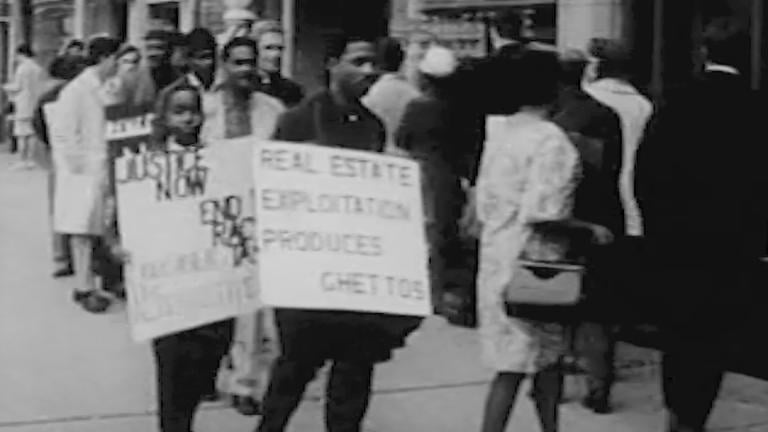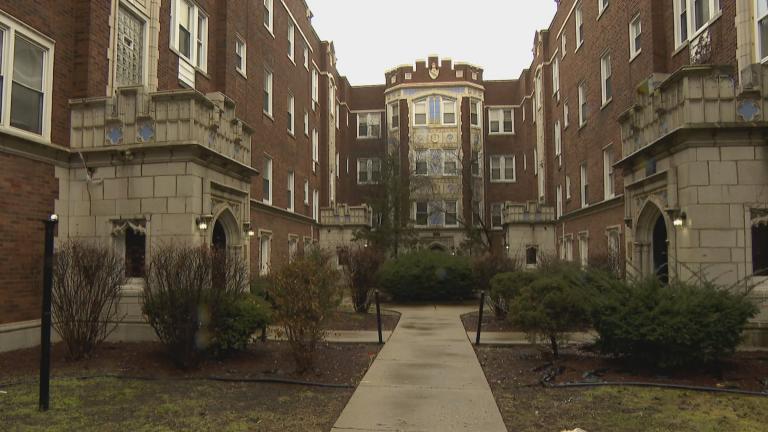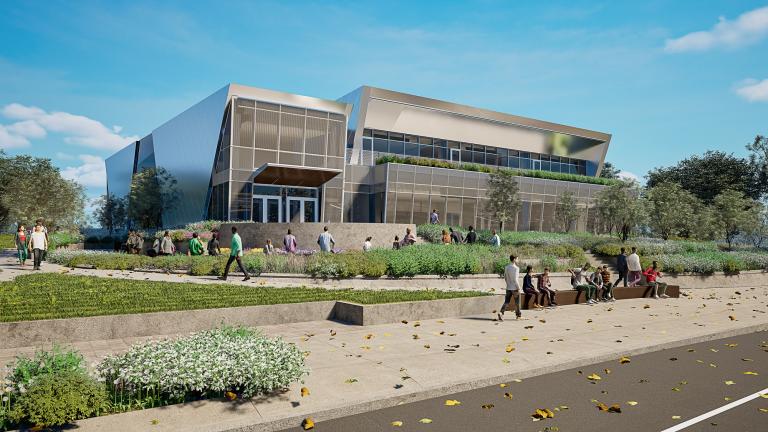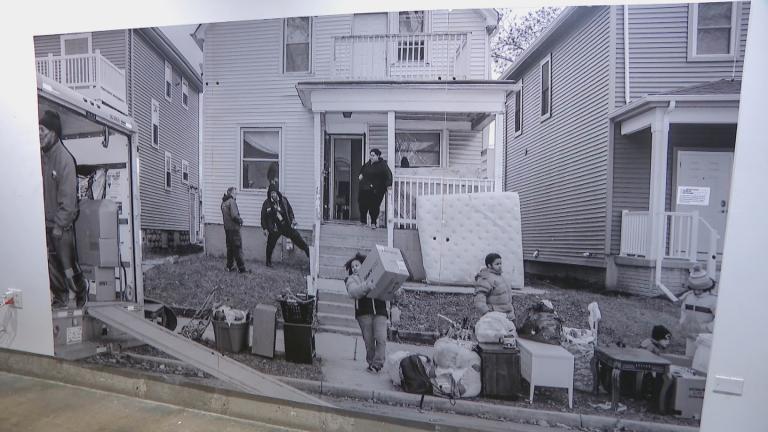Video: Housing Commissioner Marisa Novara and Roberto Requejo, the program director for Elevated Chicago, join “Chicago Tonight” to discuss policy changes around transit-oriented developments. (Produced by Blair Paddock)
For the better part of a decade, Chicago officials have been encouraging new developments to be built near the ‘L’, hoping to boost neighborhoods where people are more likely to hop a train to get to work or meet up with friends than jump in a car.
But like so many well-intentioned policies, Chicago officials found themselves confronting a series of unintended consequences that helped supercharge the deep inequities facing Chicago and its residents, including racial and economic segregation.
Efforts to rethink the policy and spur development on the South and West sides while preventing long-time residents from being displaced from the Northwest Side are starting to pay off, symbolized by the grand opening set for Friday of an apartment complex near the CTA Blue Line Logan Square station, Housing Commissioner Marisa Novara told WTTW News on Thursday.
Built by Bickerdike Redevelopment Corp., all 100 units in the Emmett Street development in Logan Square will be earmarked for low- and moderate-income families — the first transit-oriented development to cater to long-time residents of the Northwest Side.
Novara said Chicago is at an important point in the fight to stop the displacement of residents from the Northwest Side and to encourage development on the South and West sides.
Housing officials plan to take up an ordinance May 25 to bolster the city’s policy to encourage transit-oriented development by boosting incentives and increasing pedestrian safety while increasing the amount of affordable housing being built near train stations and along bus lines.
“We’re certainly pushing very hard on this,” Novara said. “We’re putting our money where our mouth is.”
Developments that maximize the number of homes by reducing the amount of parking is the best way to do that, Novara said.
Roberto Requejo, the program director for Elevated Chicago, which has partnered with the city to revamp the city’s transit-oriented development, said he hoped projects like Emmett Street would become the “norm across Chicago, not the exception.”
In addition to the Logan Square project, two transit-oriented developments are set for the city’s South Side, with the 43 Green development set to open in Bronzeville in March. That $100 million development will build 99 units, with 55 of those homes set aside for low- and moderate-income Chicagoans, near the 43rd Street station on the CTA Green Line, according to plans approved by city officials.
Phillip Lomax Beckham III, a principal with the P3 Markets, developer of 43 Green, said the project was not a hard sell to Bronzeville residents.
“Everyone knows on the South Side when you take the train to the North Side, it is exactly what is there,” Beckham said. “People were just anxious for it to happen on the South Side.”
Charlton Hamer, senior vice president of Habitat Affordable Group, which partnered with P3 Markets, said he hoped 43 Green would spur other similar developments on the South Side.
43 Green was more than just an apartment complex, with shops on the ground floor, Beckham said, adding that it was was long overdue. The project will help reinvigorate a “dead retail corridor” and help boost the declining population of Chicago’s South Side.
“This is not just a building for this community, this is personal,” Beckham said. “It is an investment in the culture of Bronzeville. It is a lot more than a building.”
A 56-unit complex is set to be built near the Cottage Grove Station on the CTA Green Line as part of the Park Station Lofts project approved by the Chicago City Council in September. Forty of those units will be set aside for low- and moderate-income Chicagoans, according to plans approved by city officials.
All three are the kinds of developments envisioned by the city’s Equitable Transit-Oriented Development policy, known as eTOD, Novara said.
Novara said she is hopeful that developers will look at Emmett Street and 43 Green and follow the paths they have blazed with projects that fit specific neighborhoods.
With the support of former Mayor Rahm Emanuel, the Chicago City Council agreed in 2013 to allow large apartment complexes to be built along CTA train stations — without the usual number of parking spaces, in order to increase the area’s density.
The city’s TOD policy was expanded in 2019 to include 20 corridors with high-frequency bus lines, increasing the amount of city land where those projects could be built by 64%, according to city officials.
But the city’s policy — which built only market-rate homes — proved to be highly inequitable, with more than 90% of transit-oriented developments built on the North Side, Northwest Side, downtown and around the West Loop, according to a city report.
“That’s a real lost opportunity and it is very inequitable,” Novara said. “So we knew we needed to act differently.”
While transit-oriented developments essentially avoided the South and West sides entirely, the developments on the Northwest Side turbocharged the displacement of working-class residents, many of whom were Latino, from Logan Square and Wicker Park with the construction of high rises along the Blue Line that attracted Millennials and members of Gen Z who commuted to work downtown.
“People want to live in communities that are walkable,” said Juan Sebastian Arias, a housing policy advisor to Mayor Lori Lightfoot. “We have made a very intentional shift to live out the equity part of it.”
Beyond backing the special permission these projects need from the City Council, Lightfoot has also supported subsidies for these developments in the form of funds from tax-increment financing districts, state tax credits and $10 million from the Chicago Recovery Plan, which is designed to help the city recover from the COVID-19 pandemic.
The unforeseen impact of the city’s transit-oriented development policy also had a significant impact on Northwest Side politics, fueling the rise of two members of the City Council’s Democratic Socialist Caucus, Ald. Carlos Ramirez Rosa (35th Ward) and Ald. Daniel La Spata (1st Ward.)
The changes to the city’s transit-oriented development policy began under Emanuel and continued under Lightfoot, who vowed to support policies that reduced segregation in Chicago and increased equity. The mayor has also backed an overhaul to the city’s affordable requirements ordinance, the centerpiece to the city’s housing equity initiatives.
Intervention by the city was key to getting Emmett Street over the finish line, since the market would have favored a development that would not serve low- and moderate-income residents, said Joy Aruguete, the executive director of Bickerdike Redevelopment Corp.
“To have an affordable development near the Blue Line with family-sized units is very unusual,” Aruguete said. “It was an issue that needed to be looked at.”
Aruguete said she hoped Emmett Street would set the standard for other projects, and encourage developments designed to prevent long-time residents from being forced to leave the Northwest Side.
“There is pressure because we are the guinea pig,” Aruguete said. “We are one of the first. When you fight to do it the right way, things will unfold the way you want it to. We hope it will be a model for the other parts of the city.”
Contact Heather Cherone: @HeatherCherone | (773) 569-1863 | [email protected]








